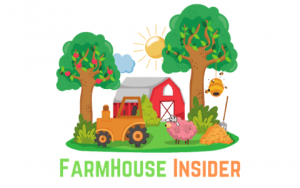A generator is an essential backup power source for many homeowners, especially during natural disasters or power outages.
However, it is crucial to have a safe and dedicated space to store your generator. A well-built generator shed not only protects your investment but also ensures the safe operation of the equipment.
In this comprehensive guide, we will walk you through the process of building your very own DIY generator shed, tailored to your specific needs and preferences.
Steps to Complete a DIY Generator Shed
Planning and Design
Before you begin constructing your generator shed, it’s essential to carefully plan and design the space to meet your needs.
- Assess your needs: Consider the size and capacity of your generator, whether you require soundproofing, and how much ventilation is needed to safely operate the generator.
- Choose the location: Select a spot that is both safe and accessible, while taking into account any local regulations or permits that may be required.
- Design the layout: Sketch a floor plan for the shed, considering the placement of doors, windows, and ventilation systems.
Materials and Tools
Gather all the necessary materials and tools for the project, including:
- Lumber
- Roofing materials
- Insulation
- Hardware (screws, nails, etc.)
- Essential tools (measuring tape, saw, drill, etc.)
Building the Foundation
Choose the type of foundation that suits your needs and the location of your shed. There are three main options: concrete slab, pier, beam, or skid foundation. Once you’ve selected your foundation type, prepare the site and construct the foundation accordingly.
Framing the Shed
Now it’s time to frame your generator shed:
- Build the walls: Cut and assemble the wall studs, install the wall sheathing, and add insulation if desired.
- Construct the roof: Assemble the roof trusses, install the roof sheathing, and apply the roofing materials.
Installing Doors, Windows, and Ventilation
- Add a door: Frame the door opening, install the door, and apply weatherstripping for a tight seal.
- Install windows (optional): Frame the window opening and install the window.
- Ventilation and exhaust systems: Choose between passive or active ventilation, and ensure there is a proper exhaust system for generator fumes.
Finishing Touches
With the main structure in place, it’s time for the finishing touches:
- Install exterior siding and trim: Choose your preferred materials and install them.
- Paint or stain the shed to protect it from the elements and improve its appearance.
- Add interior storage solutions and organize your generator accessories.
- Consider lighting and electrical options for added convenience.
Safety Precautions and Maintenance
Ensure your generator shed is safe and well-maintained:
- Implement fire safety measures, such as using fire-resistant materials and installing fire extinguishers and alarms.
- Perform regular maintenance tasks, like inspecting the shed structure, cleaning ventilation systems, and managing pest control.
- Always follow generator safety tips when operating your equipment.
Related Post
DIY Generator Shed Plans
1. 4 X 4 DIY generator shed plan
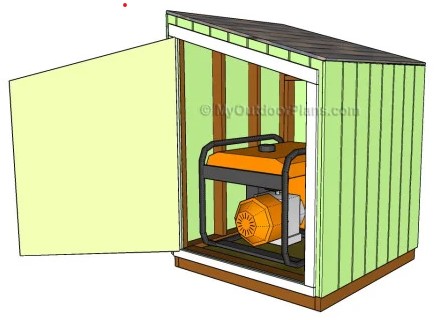
A 4×4 generator shed plan is a design blueprint for a small shed that measures 4 feet by 4 feet in size, which is specifically intended to house a generator. This shed is typically constructed out of wood or metal materials and is often designed with a sloped roof to help prevent rainwater and debris from accumulating on top of the shed. The shed may also feature vents to help promote air circulation and reduce the risk of overheating. The 4×4 generator shed plan typically includes detailed instructions for building the shed, as well as a list of required materials and tools.
2. 5×7 portable generator shed plan
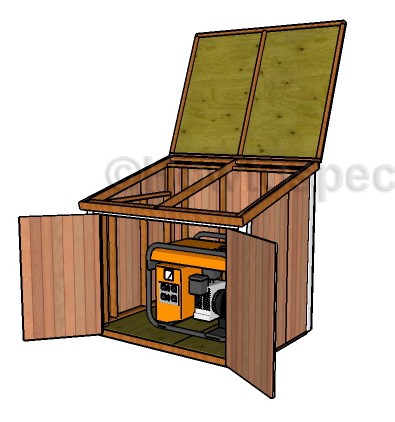
When designing a 5×7 portable generator shed plan, there are several key aspects to consider. The overall concept should revolve around creating a compact, sturdy, and functional enclosure that protects the generator from the elements while ensuring easy access for maintenance and operation.
3. Durable Portable Generator Enclosure or a Generator Baffle Box

When creating a durable portable generator enclosure or generator baffle box, the overall concept should focus on providing maximum protection for the generator while ensuring proper ventilation, noise reduction, and ease of access for maintenance.
4. DIY Quiet Sound Insulation with Exhaust Muffler plan

Creating a quiet sound insulation plan with an exhaust muffler for your generator can greatly reduce noise emissions and create a more pleasant environment. Start by selecting a high-quality exhaust muffler designed for your generator model. Carefully install it in the exhaust system to effectively dampen noise. Next, focus on sound insulation by using materials such as acoustic panels, mass-loaded vinyl, or foam insulation. Cover the generator housing and any gaps with these materials to absorb and block sound. Additionally, ensure proper ventilation to prevent overheating. With this DIY plan, you can enjoy a quieter generator experience while minimizing disturbances for yourself and those around you.
5. simple wooden outdoor generator enclosure

Building a simple wooden outdoor generator enclosure provides a cost-effective and practical solution for protecting your generator from the elements. To create this enclosure, start by selecting durable, weather-resistant wood such as treated lumber. Design the structure with ample space to accommodate your generator comfortably, allowing for proper ventilation and access for maintenance.
Ensure the enclosure has a sturdy foundation, such as concrete blocks or a level platform, to provide stability. Build walls and a roof using the chosen wood, and consider adding a hinged door for easy generator access. Remember to include vents for proper airflow and cooling. With this straightforward plan, you can construct a reliable and functional wooden outdoor generator enclosure that will help safeguard your generator for years to come.
6. DIY plastic generator shed for outdoor use

Creating a DIY plastic generator shed for outdoor use offers an excellent option for protecting your generator from the elements while providing durability and ease of maintenance. Start by selecting a sturdy, weather-resistant plastic material such as PVC or polycarbonate sheets. Design the shed to accommodate the dimensions of your generator, allowing sufficient space for ventilation and access. Construct the walls, roof, and floor using plastic sheets, securing them together with screws or adhesive.
Ensure proper airflow by incorporating vents or louvers to prevent overheating. Consider adding a hinged door with a latch for easy generator retrieval and security. With this DIY plastic generator shed plan, you can construct a reliable and lightweight enclosure that offers excellent protection against the outdoor elements while maintaining portability and ease of use.
7. Rain-Proof Portable Generator Housing DIY
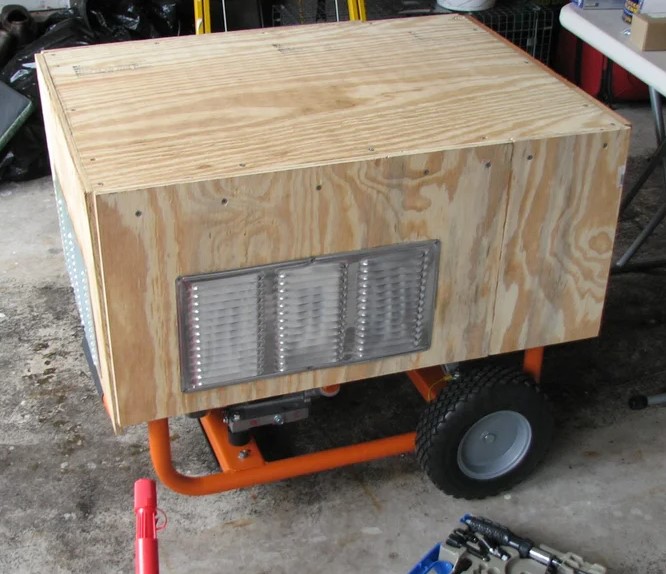
Constructing a rainproof portable generator housing is essential for safeguarding your generator from water damage during outdoor use. To create a DIY rainproof housing, start by selecting a sturdy and waterproof material such as treated plywood or plastic. Design the housing to fit the dimensions of your generator, allowing enough space for ventilation and access. Build a solid base or foundation to support the housing and elevate it slightly above the ground to prevent water from seeping in.
Ensure proper ventilation by incorporating vents or openings with covers to keep the rain out while allowing for adequate airflow. Install a sloped roof with a waterproof material such as metal or shingles to effectively divert rainwater away from the housing. Finally, seal all joints and gaps with silicone or weather stripping to create a watertight enclosure. With this DIY rainproof generator housing, you can confidently operate your generator outdoors, even in inclement weather, knowing it is well-protected from rain and moisture.
8. portable DIY generator shed

A portable DIY generator shed is a versatile and convenient solution for protecting your generator while maintaining its mobility. With this project, you can design and build a shelter that is customized to your generator’s size and your specific needs. Start by choosing durable materials such as treated lumber, plywood, or metal sheets. Design the shed with proper dimensions to accommodate your generator, ensuring there is ample space for ventilation and maintenance access.
Consider incorporating features like hinged doors, handles, and wheels to enhance portability. Pay attention to ventilation by including vents or louvers to prevent overheating. Additionally, ensure the shed is weatherproof by sealing joints and using weather-resistant materials. With a portable DIY generator shed, you can safely and conveniently transport and protect your generator wherever it is needed.
9. concrete DIY generator shed
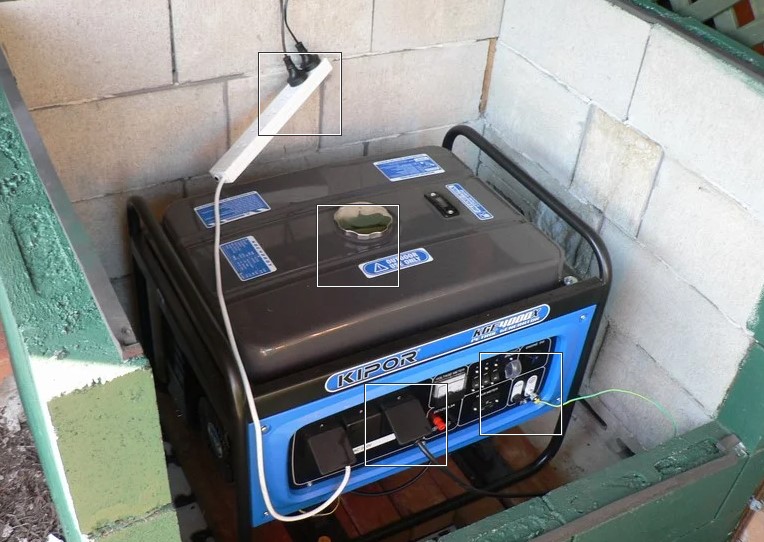
Constructing a concrete DIY generator shed offers a durable and long-lasting solution for housing your generator. A concrete shed provides excellent protection against the elements and is resistant to fire, pests, and rot. To build a concrete generator shed, start by designing a solid foundation using concrete footings or a slab. Ensure the foundation is level and properly reinforced with rebar for added strength.
Construct the walls using concrete blocks or pour them into place using concrete forms. Include windows or vents for ventilation and a sturdy door for access. Consider adding a pitched roof with shingles or a waterproof membrane to ensure water runoff. Finally, seal any gaps or cracks to make the shed watertight. With a concrete generator shed, you can have peace of mind knowing that your generator is housed in a robust structure that will protect it for years to come.
Conclusion
Building a DIY generator shed is a rewarding project that will protect your generator and provide a safe, efficient space for its operation. With proper planning, design, and construction, your shed will be an invaluable addition to your home. Don’t hesitate to start your project today and take advantage of the many benefits a generator shed can offer. For additional information and support, consult online resources or consult with local experts. Happy building!
Recent Posts
Yes, synthetic oil can generally be used in generators. It offers superior lubrication, improved resistance to temperature variations, and longevity compared to conventional oil, which can enhance...
In today's digital age, our dependency on computers and other electronic devices is undeniable. But what happens when a power outage occurs? This is where generators come in. However, is it safe to...
